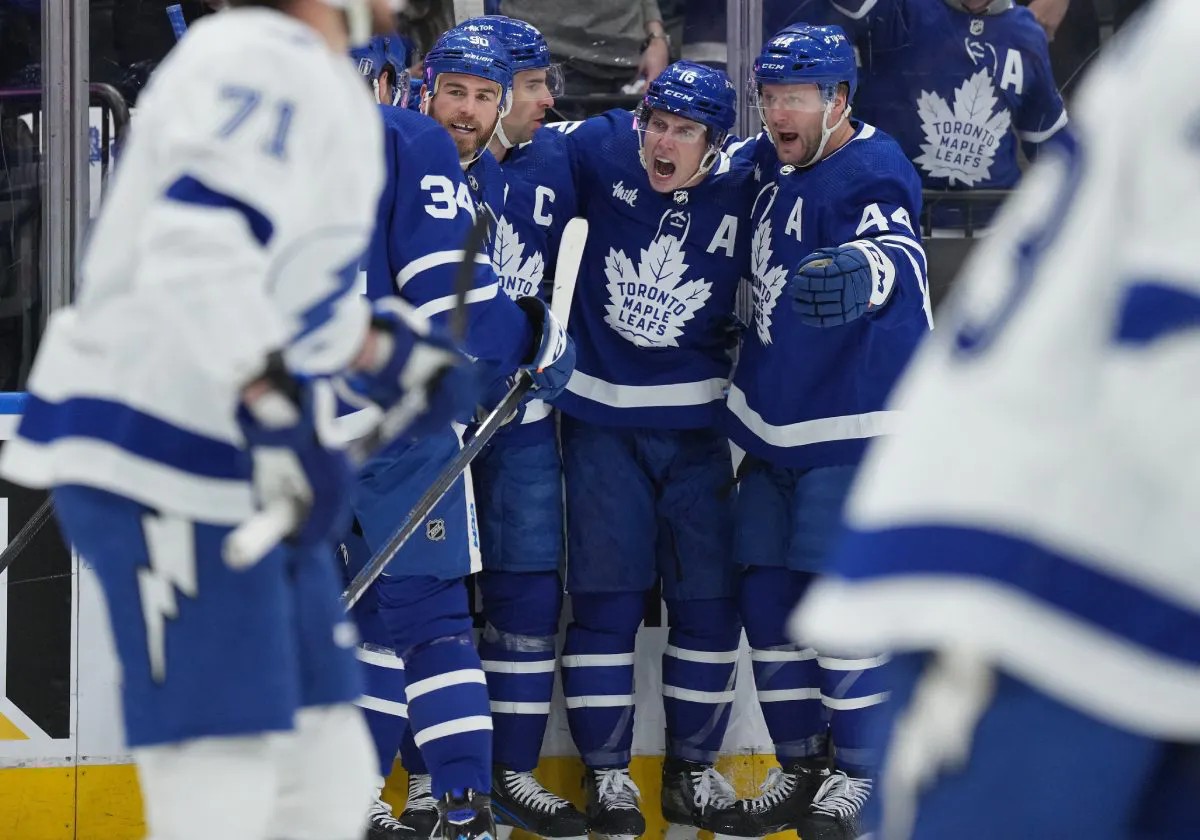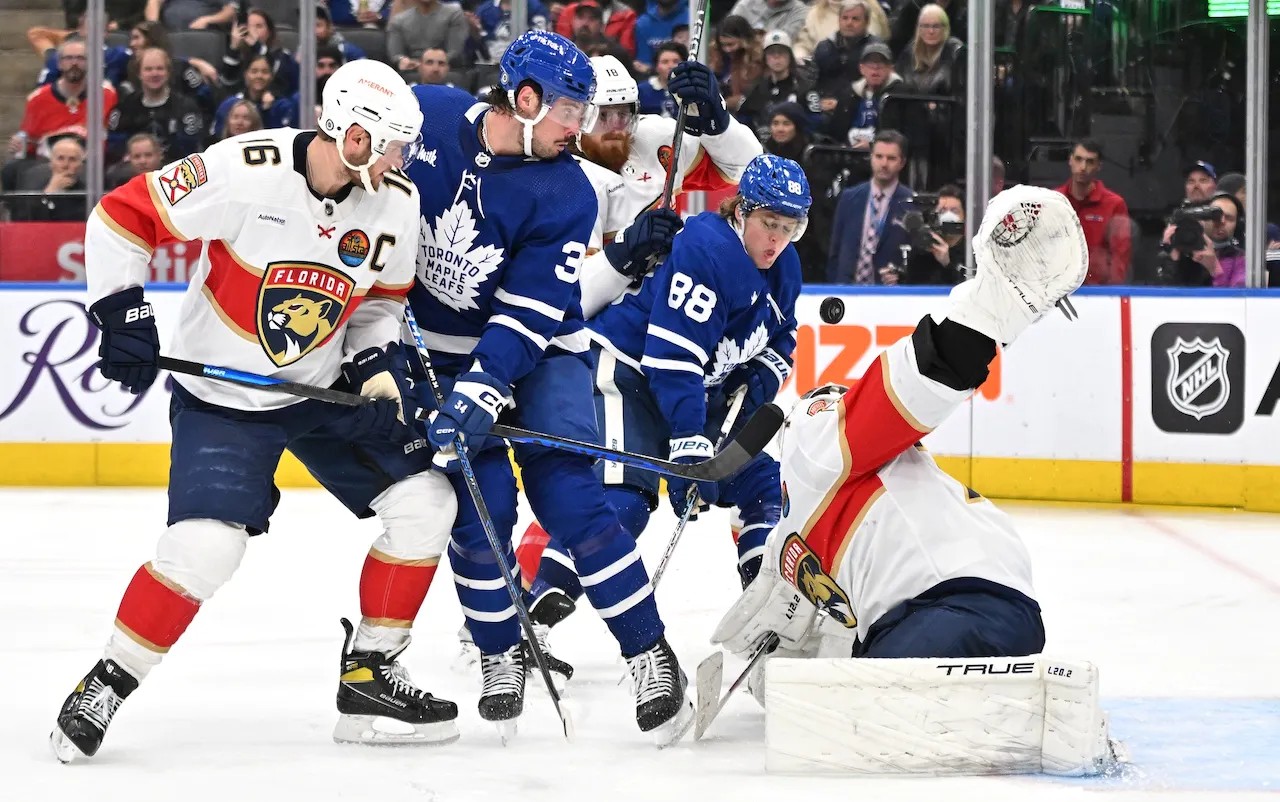The second-round matchup is set. In a bit of a shocker, the Toronto Maple Leafs have retained home-ice advantage and will play the Florida Panthers.
A lot of people are going to look at the 43-point difference between the Panthers and Bruins and be happy to see who the Leafs are playing, but it would be a mistake to underestimate this Florida team.
There’s a lot of evidence that this Panthers team is really good. This past regular season, they finished third in the league in 5v5 corsi and fifth in 5v5 expected goals. Both marks ranked ahead of the Leafs.
Here’s how the overall team numbers shook out this season:
| Goals/game | GA/game | PP% | PK% | 5v5 Corsi | 5v5 xGF% | 5v5 SV % | |
|---|---|---|---|---|---|---|---|
| Leafs | 3.39 | 2.68 | 26 | 81.9 | 51.07 | 53.45 | 92.36 |
| Panthers | 3.51 | 3.32 | 22.8 | 76 | 54.33 | 53.73 | 91.8 |
Though they went down 3-1, as the series turned on the Bruins, Florida looked like the younger, fresher, and hungrier team. If nothing else, the Bruins really showed their age. Patrice Bergeron is turning 38 in July and David Krejci just turned 37. Those are their top two centers, and the grind of the playoffs is not built for aging players to carry the mail every other night.
By comparison, the Panthers’ top 10 scorers this season are all between the ages of 23 and 28, and that doesn’t include Anthony Duclair (27 years old), who only played 20 games this season.
They run three lines that are all dangerous – one anchored by Alexsander Barkov, one by Matthew Tkachuk, and one by Sam Reinhart. Similar to Tampa, they are aggressive on the forecheck and attack with numbers.
Here is an example of a Panthers goal where at the very beginning of the video, Anton Lundell is already deep in the offensive zone forechecking Brandon Carlo. When the puck goes around to the other side, Eetu Luostarinen is right there to apply pressure and throw a hit. Aaron Ekblad pinches and wins the race to the puck to complete the turnover. From there, they execute a quick passing play and bury it for a goal.
That’s two forwards in deep and an aggressive defenseman. They did it all series to the Bruins.
On a different play here, where a line change is taking place, the Panthers hop the boards and immediately pressure the Bruins defense. They then jump the pass and make the Bruins pay in short order.
They play fast and fearlessly. Lots of underdogs retreat and try to play defense, hoping for some breaks (a counterattack, a power play, etc.) to steal games. We have seen teams do this to the Leafs in the playoffs and regular season over the past few years. The Panthers just straight up attack.
Against Tampa Bay, the Leafs had a lot of trouble with their forecheck, so this is something to focus on. Tampa’s speed was a problem, and I would argue the Panthers are even faster than the Lightning. Can the Leafs break out effectively and avoid costly mistakes, unlike the Bruins?
The Panthers forward group is full of talent beyond the top three line anchors already mentioned. Carter Verhaeghe scored 42 goals this season and Sam Reinhart has scored 30+ in back-to-back seasons. Sam Bennett is a needle mover. Anthony Duclair racked up 31 goals last season and is one of the faster wingers in the league. Luostarinen and Lundell are not very well known, but they are both quality players. Ryan Lomberg is a good pest and finds ways to make his mark (if he returns from injury).
The top three lines are really good, but their fourth line – much like the Leafs against Tampa – doesn’t give you much pause. The Panthers ended the series with a fourth line of Colin White – Eric Staal – Zac Dalpe. Both White and Dalpe didn’t even average eight minutes per game in the series against Boston.
On defense, it’s a different story. Brandon Montour produced a monster season and really blossomed into a difference-maker. Aaron Ekblad and Gustav Forsling (who led all Panthers in time on ice against the Bruins, for the record) are a legitimate top pairing that graded out well in terms of shot share, scoring chances, and expected goals, but they were victimized by some poor goaltending in the regular season (only outscoring opponents by one together). In the first round against the Bruins, Florida’s underlying numbers dipped, but this top pair outscored the Bruins 7-2 at 5v5 together. I would imagine that Paul Maurice will look to get them out there against Auston Matthews as much as possible.
After the top pair, it falls off of a cliff relatively speaking. Marc Staal was fourth among Panthers defensemen in time on ice against the Bruins followed by Radko Gudas and Josh Mahura. Staal has put together an excellent career and is a cagey veteran of sorts, but his footspeed is all but gone at 36. He can be exploited, and as a lefty in the top four, it means he’d be seeing lots of Mitch Marner and William Nylander. The Leafs need to abuse that matchup as much as humanly possible.
The Panthers own an aggressive three-line attack with one legitimately good defense pairing along with another very good defenseman in Montour, who is asked to carry his partner as the Panthers piece together the rest of the defense around him. Their sixth defenseman, Josh Mahura, played all seven games and averaged under 11 minutes per game.
In net, it’s a jigsaw puzzle. Sergei Bobrovsky started the final four games and played two good games and two not-so-good games. Even in Game 7, he gave up a really poor rebound with 15 minutes left in the third to gift the Bruins the lead. In 50 career playoff games, Bobrovsky has a .900 save percentage.
Alex Lyon is a 30-year-old journeyman who caught fire down the stretch followed by an up-and-down playoff showing in round one. In terms of substance and credibility, it would be difficult to put much stock into either, but both have been competent in the past month or so when the Panthers have needed them, so they can’t be completely discounted altogether.
In the regular season, the Leafs ranked eighth in 5v5 save percentage and the Panthers ranked 12th. I was not expecting it to be so close before I looked into the numbers.
One area to highlight is the Panthers’ penalty kill. They ranked 23rd this season and killed under 60 percent of their power plays against the Bruins in the first round. They got absolutely worked, and Tyler Bertuzzi caused them fits down low and in front of the net. John Tavares and ROR aren’t exactly the same as Bertuzzi, but they are both capable of dominating the top of the crease, whether it’s screening the goalie, deflecting pucks, winning rebounds, or making little passes to teammates down low.
Nobody in the league took more minor penalties than the Florida Panthers this season and nobody in the first round of the playoffs took more penalties than the Florida Panthers. The Leafs’ power play was very good in the first round, and if they keep it up as the Panthers take a pile of penalties, there’s not much to overthink in terms of how this could play out.
The Panthers are a good team with a formidable three-line attack and a legitimate top pairing. Their defense depth is vulnerable, they take a lot of penalties, and they struggle to kill them off. There are a lot of areas for the Leafs to exploit, and Toronto has a three-line attack of their own that they can run out there head-to-head with the Panthers.
Takeaways from the Lightning series

I wanted to end with some outstanding notes from the Leafs-Lightning series:
– Last year, I had the Leafs slightly ahead of Tampa Bay going into the trade deadline, and then Tampa swung for Nick Paul and Brandon Hagel (while the Leafs added Mark Giordano, Ilya Lyubushkin and Colin Blackwell), which ultimately pushed them just over the top against the Leafs. This year, Kyle Dubas went for broke, namely adding ROR, Jake McCabe, Noel Acciari, and Luke Schenn. That made the difference. I find it hard to see them winning those series without all of those moves. To make all of them and for the coaching staff to sort it all out and make it work is a credit to everyone involved.
– Now that the series is over, the Leafs have won and the joy of the victory has been, well, enjoyed, I think it’s time to be honest and note that the Lightning generally outplayed the Leafs. Tampa recorded the second-highest possession numbers in the first round at 5v5, came out ahead in expected goals, and actually outscored the Leafs at 5v5 15-14. There’s no real argument to make that the Lightning didn’t outplay Toronto.
– The Leafs found ways to win, Ilya Samsonov was excellent, they got timely scoring, and there was a bend-don’t-break, almost team-of-destiny vibe to their play. For many years, one line of thinking about the Leafs in the playoffs has been that once the monkey is off their back, they will relax, build some momentum, and go on a deep run. They are a better team than they showed at 5v5 and have a whole different level that they are capable of reaching. At some point, they will need to find it.
– A series where the team starts poorly in five of six games is not a good recipe for success – neither is getting outplayed as well as outscored at 5v5. When the Leafs did enter the offensive zone, they were able to sustain offense and have some extended zone time. That was not the issue. It was breaking out and traversing the neutral zone. Tampa pressed them and forced turnovers while the Leafs were often trying to make plays instead of sometimes simply chipping pucks in and creating races.
– On the flip side, it was really surprising just how passive the Leafs were in the neutral zone. They gave Tampa a lot of space to skate through the middle of the ice and gain the zone. Often, their defensemen played behind the blue line, ceding space. This wasn’t how they played for most of the season, so it was a little surprising to see. We’ll see if this was a strategy for playing against Tampa specifically or something they will continue rolling with. On the surface, not blitzing Marc Staal seems like a mistake.
– This was the calmest I’ve seen this Leafs core in critical moments. When they went down, they didn’t force anything. They didn’t get frustrated when things didn’t go their way at times. When Tampa engaged in shenanigans, it helped having Luke Schenn as a patrol cop of sorts. There was no gamesmanship in which the Leafs were dunked on in this series. They were focused, didn’t get rattled, and when the series was over, they looked ready for more.
– The Leafs started the series with a third line of Kerfoot-Acciari-Jarnkrok that was predictably poor. After the first game, ROR moved to L3 and anchored the line, giving the Leafs the three-line attack we have talked about for so many years. I think one of the most sneaky benefits of the whole line shifting was moving Acciari back to the wing. He can capably play center, but as most centers do, he hangs back and plays higher up in the zone to take care of the defensive side; meaning, they don’t get to fully utilize him on the forecheck in the same way.
I thought he was excellent in Game 6, in particular, with one forecheck where he set up Matthews for a good chance as well as a number of good battles to get pucks out along the wall. Just because he can capably play center doesn’t mean he should be there. He is a winger.
– It wasn’t always pretty with McCabe-Brodie in the first series (and their 5v5 shot share percentage was just 40 percent, although expected goals was around 47), but all in all, they actually outscored Tampa 2-1 together at 5v5. Brayden Point and Nikita Kucherov, – who they primarily matched up against – combined for zero even-strength goals. Steven Stamkos scored two. If you’re a Leafs partisan, you would sign on the dotted line for that type of output from each team’s top line.
– Sheldon Keefe did a good job bouncing between Matthews-Marner and Matthews-Nylander after the first few games of the series that were almost exclusively Matthews-Marner. As always, it’s important to note that this is not a one-or-the-other situation. There is a time and place for either duo, and it’s important to not get stuck on one. To me, switching to Matthews-Nylander was the start of the swing of Game 4 and helped to eventually secure the overtime win.
– Matthews scored the only goal in regulation in Game 6 on a sequence where he launched three shots in a span of about 13 seconds. Looking back on the series, Matthews had a number of shifts like that, which is to say he just demanded the puck as the Leafs buzzed around the offensive zone and launched shots on net whenever possible. Last playoff – and the ones previous – I thought he passed on good shooting opportunities (This one always stood out to me (passing to Marner to shoot when he was in the middle of the ice). That was not the case in this series. It also helps that he shot the highest percentage of his career in the playoffs.
– In general, I thought all the Leafs’ top players were good and productive. It speaks for itself, really; all of them were over a point per game. Morgan Rielly has once again elevated his game come playoff time. He has done this for years now, and it’s safe to say he’s clearly capable of finding a whole new level at this time of year. With the team currently capable of coasting to a playoff spot, it’s fair to say it’s not even remotely worth criticizing him in the regular season if he’s going to play like this every spring.
– Michael Bunting was really good in his return to the lineup in Game 6. He had great energy, avoided the nonsense, and he was involved in creating some offense. Bunting is a good player when he focuses on playing between the whistles rather than getting caught up in trying to draw penalties or engage in the antics. They need what he brings as they aren’t particularly deep on left wing. John Tavares moved to the spot at times in Game 6. Matthew Knies has been really good offensively, but like most young players entering the league, he needs to work on his play on the other half of the ice. Hopefully, round one was a wake-up call for Bunting.
– ZAR and Sam Lafferty played their way out of the playoff lineup in Game 6. It was fair to scratch both, and 11-7 worked reasonably well. I think 11-7 is a nice change of pace, but it’s hard to count on it every other night over two months. The playoff grind is a war of attrition. I’m sure there are already forwards playing hurt. They will probably have to bounce between the two at times, and at least one of Lafferty/ZAR is going to need to step up and give the team some good games.
– I said it after Game 6 and it remains true: That was the first series in the Matthews/Marner/Nylander era in which the Leafs truly got the better goaltending. Lo and behold, they won.

































